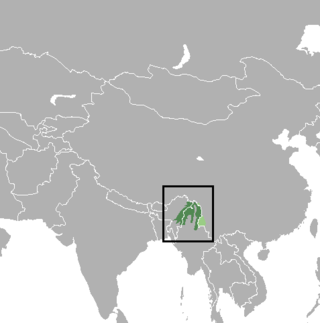
Arunachal Pradesh is a state in northeast India. It was formed from the North-East Frontier Agency (NEFA) region, and India declared it as a state on 20 February 1987. Itanagar is its capital and largest town. It borders the Indian states of Assam and Nagaland to the south. It shares international borders with Bhutan in the west, Myanmar in the east, and a disputed 1,129 km border with China's Tibet Autonomous Region in the north at the McMahon Line. Arunachal Pradesh is claimed by China as part of the Tibet Autonomous Region; China occupied some regions of Arunachal Pradesh in 1962 but later withdrew its forces.

Northeast India, officially known as the North Eastern Region(NER) is the easternmost region of India representing both a geographic and political administrative division of the country. It comprises eight states—Arunachal Pradesh, Assam, Manipur, Meghalaya, Mizoram, Nagaland and Tripura (commonly known as the "Seven Sisters"), and the "brother" state of Sikkim.

The gayal, also known as the Drung ox or mithun, is a large domestic cattle distributed in Northeast India, Bangladesh, Myanmar and in Yunnan, China.

The Mishmi people are an ethnic group of Tibet and Arunachal Pradesh, India. The area is known as the Mishmi Hills. Only one group, called the Deng, occupy Zayu County in southern Tibet.
The Indian state of Arunachal Pradesh has a total population of roughly 1.4 million on an area of 84,000 km2, amounting to a population density of about 17 pop./km2. The "indigenous groups" account for about two thirds of population, while immigrants, mostly of Bengali/Hindi belt origin, account for the remaining third.

The Wancho people, also known as the Wancho Naga, are a Tibeto-Burmese indigenous ethnic group inhabiting the Patkai hills of Longding district in the Northeast Indian state of Arunachal Pradesh. Wancho's history is mostly based on present day Nagaland.Even today, There are villages in Wancho inhabited area in Arunachal and konyak inhabited Mon Nagaland with the same names for example Longkei village. The Wancho language belongs to the Tibeto-Burman family under Northern Naga languages.

Nagas are various ethnic groups native to northeastern India and northwestern Myanmar. The groups have similar cultures and traditions, and form the majority of population in the Indian state of Nagaland and Naga Self-Administered Zone of Myanmar (Burma); with significant populations in Manipur, Arunachal Pradesh and Assam in India; Sagaing Region and Kachin State in Myanmar.

The leaf muntjac, leaf deer or Putao muntjac is a small species of muntjac. It was documented in 1997 by biologist Alan Rabinowitz during his field study in the isolated Nogmung Township in Myanmar. Rabinowitz discovered the species by examining the small carcass of a deer that he initially believed was the juvenile of another species; however, it proved to be the carcass of an adult female. He managed to obtain specimens, from which DNA analysis revealed a new cervid species. Local hunters knew of the species and called it the leaf deer because its body could be completely wrapped by a single large leaf. It is found in Myanmar and India.

Lohit is an administrative district in the state of Arunachal Pradesh in India. The district headquarters is located at Tezu. As of 2011 it is the third most populous district of Arunachal Pradesh, after Papum Pare and Changlang.

Anjaw District (Pron:/ˈændʒɔ:/) is an administrative district in the state of Arunachal Pradesh in north-east India. It was created district in 2004, by splitting off from the Lohit district under the Arunachal Pradesh Re-organization of Districts Amendment Act. The district borders China on the north. Hawai, at an altitude of 1296 m above sea level, is the district headquarters, located on the banks of the Lohit River, a tributary of the Brahmaputra River. It is the easternmost district in India. The furthest villages towards the border with China are Dong, Walong, Kibithu and Kaho.
Rohanixalus shyamrupus, also known as the hornbill bubble-nest frog and Shyamrup's bush frog, is a species of frog in the family Rhacophoridae endemic to north-eastern India: it is only known from the type locality, Namdapha Tiger Reserve in Arunachal Pradesh.

The following outline is provided as an overview of, and topical guide to, India:

The Tibeto-Burman languages are the non-Sinitic members of the Sino-Tibetan language family, over 400 of which are spoken throughout the Southeast Asian Massif ("Zomia") as well as parts of East Asia and South Asia. Around 60 million people speak Tibeto-Burman languages. The name derives from the most widely spoken of these languages, Burmese and the Tibetic languages, which also have extensive literary traditions, dating from the 12th and 7th centuries respectively. Most of the other languages are spoken by much smaller communities, and many of them have not been described in detail.
The Council of Baptist Churches in Northeast India is a Baptist Christian denomination in North East India. It is a member of the Asia Pacific Baptist Federation. It is also a member body of the North East India Christian Council, the regional council of the National Council of Churches in India. Its presently led by Mr. Norbu Lama as President and Rev. Prof. Akheto Sema as General Secretary.
Kaman, or Miju, is a small language of India and China. Long assumed to be a Sino-Tibetan language, it may be a language isolate.

Arunachal Pradesh is primarily a hilly tract nestled in the foothills of the Himalayas in northeast India. It is spread over an area of 83,743 km2 (32,333 sq mi). 98% of the geographical area is land out of which 80% is forest cover; 2% is water. River systems in the region, including those from the higher Himalayas and Patkoi and Arakan Ranges, eventually drain into the Brahmaputra River.
The North-East Democratic Alliance is a political coalition that was formed on May 24, 2016, by Bharatiya Janata Party. The motive of the new political front was to protect the interest of the people of the region as well as uniting non-Congress parties in Northeast India. Himanta Biswa Sarma was appointed as the convenor of the front.
Polypedates subansiriensis is a species of frogs in the family Rhacophoridae. It is endemic to Northeast India and only known from its type locality, Soro village in the eponymous Lower Subansiri District, Arunachal Pradesh state. It is sometimes known as the Subansiri's tree frog or Subansiri tree frog.











